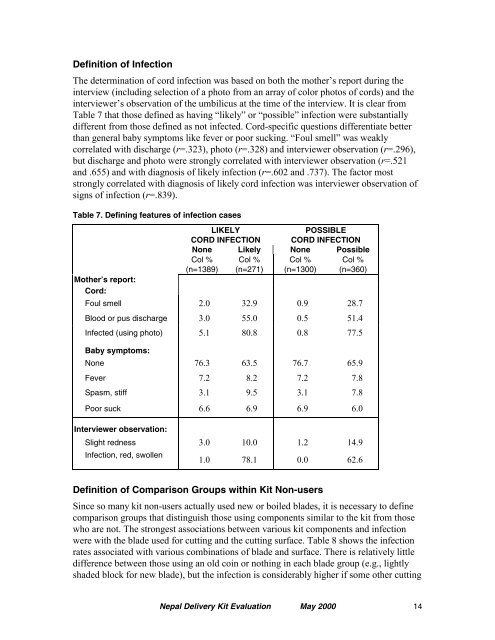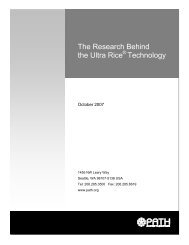Nepal Clean Home Delivery Kit: Evaluation of the Health Impact - Path
Nepal Clean Home Delivery Kit: Evaluation of the Health Impact - Path
Nepal Clean Home Delivery Kit: Evaluation of the Health Impact - Path
Create successful ePaper yourself
Turn your PDF publications into a flip-book with our unique Google optimized e-Paper software.
Definition <strong>of</strong> Infection<br />
The determination <strong>of</strong> cord infection was based on both <strong>the</strong> mo<strong>the</strong>r’s report during <strong>the</strong><br />
interview (including selection <strong>of</strong> a photo from an array <strong>of</strong> color photos <strong>of</strong> cords) and <strong>the</strong><br />
interviewer’s observation <strong>of</strong> <strong>the</strong> umbilicus at <strong>the</strong> time <strong>of</strong> <strong>the</strong> interview. It is clear from<br />
Table 7 that those defined as having “likely” or “possible” infection were substantially<br />
different from those defined as not infected. Cord-specific questions differentiate better<br />
than general baby symptoms like fever or poor sucking. “Foul smell” was weakly<br />
correlated with discharge (r=.323), photo (r=.328) and interviewer observation (r=.296),<br />
but discharge and photo were strongly correlated with interviewer observation (r=.521<br />
and .655) and with diagnosis <strong>of</strong> likely infection (r=.602 and .737). The factor most<br />
strongly correlated with diagnosis <strong>of</strong> likely cord infection was interviewer observation <strong>of</strong><br />
signs <strong>of</strong> infection (r=.839).<br />
Table 7. Defining features <strong>of</strong> infection cases<br />
Mo<strong>the</strong>r’s report:<br />
Cord:<br />
LIKELY<br />
CORD INFECTION<br />
POSSIBLE<br />
CORD INFECTION<br />
None Likely None Possible<br />
Col %<br />
(n=1389)<br />
Col %<br />
(n=271)<br />
Col %<br />
(n=1300)<br />
Col %<br />
(n=360)<br />
Foul smell 2.0 32.9 0.9 28.7<br />
Blood or pus discharge 3.0 55.0 0.5 51.4<br />
Infected (using photo) 5.1 80.8 0.8 77.5<br />
Baby symptoms:<br />
None 76.3 63.5 76.7 65.9<br />
Fever 7.2 8.2 7.2 7.8<br />
Spasm, stiff 3.1 9.5 3.1 7.8<br />
Poor suck 6.6 6.9 6.9 6.0<br />
Interviewer observation:<br />
Slight redness 3.0 10.0 1.2 14.9<br />
Infection, red, swollen<br />
1.0 78.1 0.0 62.6<br />
Definition <strong>of</strong> Comparison Groups within <strong>Kit</strong> Non-users<br />
Since so many kit non-users actually used new or boiled blades, it is necessary to define<br />
comparison groups that distinguish those using components similar to <strong>the</strong> kit from those<br />
who are not. The strongest associations between various kit components and infection<br />
were with <strong>the</strong> blade used for cutting and <strong>the</strong> cutting surface. Table 8 shows <strong>the</strong> infection<br />
rates associated with various combinations <strong>of</strong> blade and surface. There is relatively little<br />
difference between those using an old coin or nothing in each blade group (e.g., lightly<br />
shaded block for new blade), but <strong>the</strong> infection is considerably higher if some o<strong>the</strong>r cutting<br />
<strong>Nepal</strong> <strong>Delivery</strong> <strong>Kit</strong> <strong>Evaluation</strong> May 2000 14
















